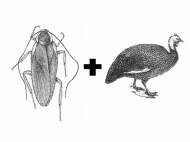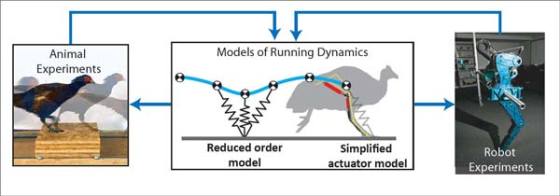For a fast walking robot combine a guinea hen with a cockroach
 After writing about biomimicry of penguins, sharks, butterflies and bats, we’re going to write about cockroach biomimicry. Although the sight of a crawling cockroach dashing for cover may be repulsive, the insect is also a biological and engineering marvel. Cockroaches and guinea hens serve as bioinspiration to the researchers at Oregon State University where they are trying to build the world’s first legged robot capable to run over rough terrain. Their latest findings outline how animals use their legs to manage energy storage and expenditure, and why this is so important for running stability.
After writing about biomimicry of penguins, sharks, butterflies and bats, we’re going to write about cockroach biomimicry. Although the sight of a crawling cockroach dashing for cover may be repulsive, the insect is also a biological and engineering marvel. Cockroaches and guinea hens serve as bioinspiration to the researchers at Oregon State University where they are trying to build the world’s first legged robot capable to run over rough terrain. Their latest findings outline how animals use their legs to manage energy storage and expenditure, and why this is so important for running stability.
“Humans can run, but frankly our capabilities are nothing compared to what insects and some other animals can do,” said John Schmitt, an assistant professor in the School of Mechanical, Industrial and Manufacturing Engineering at OSU. “Cockroaches are incredible. They can run fast, turn on a dime, move easily over rough terrain, and react to perturbations faster than a nerve impulse can travel.”
Within certain limitations, Schmitt said, cockroaches don’t even have to think about running – they just do it, with muscle action that is instinctive and doesn’t require reflex control. That, in fact, is part of what the engineers are trying to achieve. Right now some robots have been built that can walk, but none of them can run as well as their animal counterparts. Even walking robots absorb far too much energy and computing power to be very useful.
“If we ever develop robots that can really run over rough ground, they can’t afford to use so much of their computing abilities and energy demand to accomplish it,” Schmitt said. “A cockroach doesn’t think much about running, it just runs. And it only slows down about 20 percent when going over blocks that are three times higher than its hips. That’s just remarkable, and an indication that their stability has to do with how they are built, rather than how they react.”
The OSU researchers are trying to identify some of the basic biological and mechanical principles that allow certain animals to run so well and effortlessly. A guinea hen, for instance, can change the length and angle of its spring-like legs to almost automatically adjust to an unexpected change in a ground surface as much as 40 percent of its hip height. That would be like a human running at full speed, stepping into a 40cm deep hole and never missing a beat.
In a computer model, they’ve created a concept that would allow a running robot to recover from a change in ground surface almost as well as a guinea hen. They are studying how the interplay of concepts such as energy storage and expenditure, sensor and feedback requirements, and leg angles can produce recovery from such perturbations. Ultimately, a team of OSU engineers hopes to use knowledge such as this to actually build robots that can efficiently run over rough terrain without using significant computing power.
If successful, running robots could serve valuable roles in difficult jobs, such as military operations, law enforcement or space exploration. Related technology might also be applied to improve the function of prosthetic limbs for amputees, or serve other needs.










Cockroach and guinea hen are indeed amazing examples of swiftness in running and changing directions so is squirrel. More and more scientific inventions are from Biomimicking.
Dr.A.Jagadeesh Nellore(AP),India